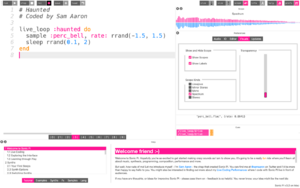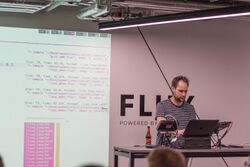Software:Sonic Pi
From HandWiki
Short description: Live coding environment
 Screenshot of Sonic Pi | |
| Developer(s) | Sam Aaron and others |
|---|---|
| Initial release | 2012 |
| Stable release | 4.5.0
/ 18 October 2023 |
| Written in | Ruby, Erlang, Elixir, Clojure, C++, and Qt |
| Operating system | Linux, macOS, Windows, Raspberry Pi OS |
| Type | Live coding environment |
| License | MIT License |
| Website | sonic-pi |
Sonic Pi is a live coding environment based on Ruby, originally designed to support both computing and music lessons in schools, developed by Sam Aaron in the University of Cambridge Computer Laboratory[1] in collaboration with Raspberry Pi Foundation.[2][3]
Uses
Thanks to its use of the SuperCollider synthesis engine and accurate timing model,[4] it is also used for live coding and other forms of algorithmic music performance and production, including at algoraves. Its research and development has been supported by Nesta, via the Sonic PI: Live & Coding project.[5]
See also
- Pure Data
- Algorithmic composition
- List of MIDI editors and sequencers
- List of music software
Further reading
- Aaron, Samuel; Blackwell, Alan F.; Burnard, Pamela (2016). "The development of Sonic Pi and its use in educational partnerships: Co-creating pedagogies for learning computer programming". Journal of Music, Technology & Education 9 (1): 75–94. doi:10.1386/jmte.9.1.75_1. https://www.repository.cam.ac.uk/bitstream/handle/1810/263177/AaronBlackwellBurnard-revised-V2.doc?sequence=1. Retrieved 11 December 2019.
- Aaron, Sam. (2016). "Sonic Pi–performance in education, technology and art.". International Journal of Performance Arts and Digital Media 12 (2): 17–178. doi:10.1080/14794713.2016.1227593.
- Sinclair, Arabella (2014). "Educational Programming Languages: The Motivation to Learn with Sonic Pi.". PPIG: 10. http://users.sussex.ac.uk/~bend/ppig2014/25ppig2014_submission_23.pdf. Retrieved 11 December 2019.
- Aaron, Samuel; Blackwell, Alan F. (2013). "From sonic Pi to overtone". Proceedings of the first ACM SIGPLAN workshop on Functional art, music, modeling & design. Farm '13. ACM. pp. 35–46. doi:10.1145/2505341.2505346. ISBN 9781450323864. https://dl.acm.org/citation.cfm?id=2505346. Retrieved 11 December 2019.
- Aaron, Samuel; Blackwell, Alan F.; Hoadley, Richard; Regan, Tim (2011). "A principled approach to developing new languages for live coding". International Conference on New Interfaces for Musical Expression (NIME). Oslo, Norway. http://www.nime.org/proceedings/2011/nime2011_381.pdf. Retrieved 16 September 2021.
- Aaron, Samuel; Blackwell, Alan F. (2013). "From sonic Pi to overtone: creative musical experiences with domain-specific and functional languages". Proceedings of the First ACM SIGPLAN Workshop on Functional Art, Music, Modeling & Design: 35–46. doi:10.1145/2505341.2505346.
References
- ↑ Blackwell, Alan; McLean, Alex; Noble, James; Rohrhuber, Julian (2014). "DROPS - Collaboration and learning through live coding (Dagstuhl Seminar 13382)". Dagstuhl Reports 3 (9): 130–168. doi:10.4230/DagRep.3.9.130. http://drops.dagstuhl.de/opus/volltexte/2014/4420/. Retrieved 2015-05-02.
- ↑ Cellan-Jones, Rory (7 October 2013). "Baked in Britain, the millionth Raspberry Pi". BBC News. https://www.bbc.co.uk/news/technology-24435809. Retrieved 2015-05-02.
- ↑ "Making music with Raspberry Pi - CBBC Newsround". http://www.bbc.co.uk/newsround/30151730. Retrieved 2015-05-02.
- ↑ Aaron, Samuel; Orchard, Dominic; Blackwell, Alan F. (2014). "Temporal semantics for a live coding language". Proceedings of the 2nd ACM SIGPLAN international workshop on Functional art, music, modeling & design - FARM '14. ACM. pp. 37–47. doi:10.1145/2633638.2633648. ISBN 978-1-4503-3039-8. https://kar.kent.ac.uk/57489/1/sonicpi.pdf.
- ↑ "Sonic Pi - The Live Coding Music Synth for Everyone". https://sonic-pi.net/. Retrieved 2019-10-05.
External links
 |


